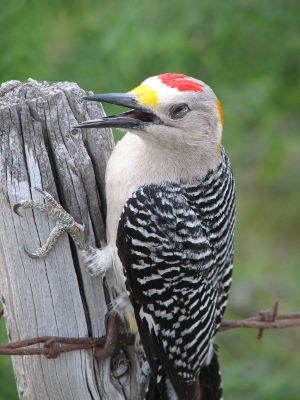Golden-Fronted Woodpecker
Category: Woodpeckers

Facts about Golden-Fronted Woodpeckers, "Scientific name for Golden-Fronted Woodpecker is Melanerpes aurifrons". Golden-fronted woodpecker is a Melanerpes type of woodpecker that comes from the Picidae family. "Scientific name for Woodpecker Picidae". Woodpeckers are birds in the Class of "Aves".
The Golden-Fronted Woodpeckers hail from the Southwestern parts of Oklahoma through Mexico and Texas. The Golden-Fronted Woodpecker are largely found in Open and semi-open forests, second-growth woodlands, and brush lands. The Golden-Fronted Woodpecker is composed of four sub varieties that vary in dimension, the color of the nape, belly and nasal tufts, and the amount of barring on the tail. While the nape of the form seen in Texas and the majority of Mexico is yellow to orange in color, the Golden-Fronted Woodpecker is red in color on the Yucatan Peninsula and orange in color in farther south.
Golden-fronted woodpeckers are regularly seen perching in the top of the dead tree or on a utility post where they can stay stationary for several minutes. The vocalizations of the Golden-Fronted Woodpeckers are analogous to those of the Red-bellied Woodpeckers, but are harsher and louder. Drumming in Golden-fronted woodpeckers is less common than in other varieties. The Golden-Fronted Woodpeckers are commonly seen individually or in pairs. They are territorial and protect their nesting trees from others of their varieties in addition from the closely associated Red-bellied Woodpeckers.
Golden-Fronted Woodpeckers are omnivores; meaning - an animal that eats food of both animal and plant and origin.
Golden-Fronted Woodpeckers are monogamous meaning- the pair will mate for lifetime. Both male and female prepare the nest in the tree for babies and both will help feed them. The female Golden-Fronted Woodpecker will lay between 3 and 5 eggs and the incubation period will lasts 11 to 14 days. After one month of hatching, young Golden-Fronted Woodpeckers will leave the nest and venture out on there own.
Golden-Fronted Woodpeckers possess a protective ocular mechanisms for protecting its eyes from shaking from the pecking impact. Golden-Fronted Woodpeckers show a restricted axial globe movement due to the tight fit within the fascial tissue connections and orbit between the sclera and orbital rim.
The eyes of the Golden-Fronted Woodpecker are covered with a nictitating membrane (from Latin nictare, to blink)— a translucent and transparent third eyelid - that protects the Golden-Fronted Woodpeckers eyes from flying debris while pecking.
Both dead and live trees are exploited for nesting, including utility poles, fence posts and artificial nest boxes. Usually, the Golden-Fronted Woodpeckers prefer old growth mesquite, but nests have been seen in such different varieties, as live oak, pecan, Anaqua, Hackberry and willow. Placement of the aperture of the nest hole ranges from near land level to as much as 35 feet (10.66 meters) with heights, ranging from 8 feet to 20 feet (2.43 to 3.04 meters) being common. Both male and female woodpeckers used to spend 6 days to 10 days in constructing their nest cavity. A cavity from an earlier year may also be employed by them. The deepness of the cavity ranges from 6 inches to 18 inches (45.7), and these woodpeckers are shy while around their nests.
Diet
The Golden-Fronted Woodpecker used to forage at all heights in trees and on the land where they look for insects. Usually, the Golden-Fronted Woodpecker feed on pecans, acorns, wild fruits, whole corn, citrus, and cornmeal. Sometimes, they feed on dog food, too.
years. There are more than 190 species of woodpeckers worldwide, but none of them are found in polar regions, Madagascar, New Zealand or Australia.
Most woodpeckers have zygodactyl feet, having 4 fingers, which means they have two toes facing the front and two toes facing the back, that helps them to have a strong grip on trees vertically. They use these 8 fingers with their stiff central portion tail feathers to brace on trees as they climb.
Features
The Golden-fronted woodpecker is an average-sized to big-sized woodpecker, with a body length, ranging from 8 11/16 inches to 10 13/64 inches (22 to 25.9 cm), with the wingspan of 16.9 inches (42.9 cm). They have a body mass that ranges from 2.3 pounds to 3.6 pounds (1 to 1.6 kg).
Male and female Woodpeckers are able to drum hollow trees logs execrate. This pecking activity also plays an important role in communicating with each other. Golden-Fronted Woodpeckers drumming is also to attract a mate, mark out territory, both sexes are known to drum.
An average Golden-Fronted Woodpeckers tongue is up to 4 inches (10.16 cm) long. The length can be a little different depending on which species of woodpecker. The Golden-Fronted Woodpecker tongue wraps around the reinforced skull structured and squashy bone, to even out the impact of the pecking force. Golden-Fronted Woodpeckers have barbed tongues that helps them remove bugs from holes and tree bark.
Feathers that look like hairs on the Golden-Fronted Woodpecker nostrils, prevent ingestion of wood particles.
When feeding, drumming and building a nest cavity, a Golden-Fronted Woodpecker can peck up to 20 times per second, wow that's fast! or a total between 9,000 and 12,000 pecks in a day.
Golden-Fronted Woodpeckers have a prominent surge in flight comprise of three rapid wing flaps, followed by a quick glide when the Golden-Fronted Woodpeckers wings are tucked against its body rather than spread out like many other birds.
The average life span of a woodpecker in the wild is 4 to 7 years, depending on the species and environment

 Back To Category Woodpeckers
Back To Category Woodpeckers